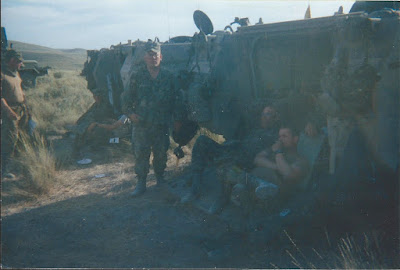 |
| Not exactly central Germany, but the character is right. |
One of the numerous hobby projects I have been working on is a set of simple Brigade scale rules for Cold War era engagements. I took the opportunity presented by a lot of business travel in May and June this year to re-read the entirety of the excellent Third World War 1987 blog. This is a rather exhaustive day by day story of the global war stemming from a Soviet Invasion of West Germany in July of 1987. The author (Mike) focuses on events across the globe, but with specific focus on NORTHAG and CENTAG in Germany. This plays very well with my 3mm Cold War project where I have built enough models to field a Soviet Mechanized Infantry or Tank division as well as a US Cavalry Regiment, Armored brigade or even a Bundeswehr Panzer Brigade.
It was this paragraph from the CENTAG update for D+15 that provided a flash of inspiration:
1st Armored Division’s attack met stiff resistance as well from the 11th Guards Tank Division. The Soviet division’s forward regiments were deployed in depth. Their initial defenses were not penetrated until around 1200. Within two hours much of the division’s MRR had been enveloped south of Stockhausen. A counterattack made up of two tank battalions hit the Americans later in the day to break through to the surrounded motor-rifle troops. It failed to reach them, however, it was enough to slow the US advance and force 1st AD’s commanding general to commit a second brigade to the fight.In the story, the Soviet 1st Guards Tank Army has been stopped West of Fulda, and establihsed a hasty defense while follow on forces are brought forward. The V Corps commander takes the opportunity to launch a limited counter attack using his freshly REFORGED 1st Infantry Division and elements of the 1st Armored Division sliced to him from US Army VII Corps. Rather than the typical "Red Horde Sweeps West" scenario, this is actually two reinforced US Armored Brigades attacking depleted Soviet divisions on the defense.
Next up, I did a quick sketch of the situation as I understood it from the story. According to the historical data the 11th GTD was comprised of three Tank regiments (7th, 40th and 44th TR) and one MRR (249th). The author specified that the 1st Armor enveloped the the MRR south of Stockhausen. Looking at the map, their is a large rise Southeast of Stockhausen where a stream cuts through the woods back towards Grossenluder. I therefore assumed the Soviets would have three regiments forward and the most depleted regiment pulled back to maintain a reserve as well as cover the flank. This resulted in the following concept map:
Taking a closer look at this terrain, it seemed the best defensive position would be a reverse slope defense of the valley to the East of Stockhausen proper. A Soviet MRR from this time period would have 3x Battalions in BMPS (MRB), 1 over strength Tank Battalion plus attached AT, Recon and Artillery elements. I opted to plot those on the map as well as put in some appropriate obstacles like tank ditches and mine fields to act as turning and blocking obstacles for the defense. (I should add that I even dug out my old OPFOR warfighting guide from the Armor Center to make sure I was at least a little doctrinally correct)
Next up the forces.
 |
| Soviet 249th MRR with reinforcements |
The Soviet Order of Battle was rather easy. Mike (the author) told me he assumed they were sitting around 60% strength. The write-up also indicated that 2 reserve tank battalions would perform the counterattack late in the battle. Thus I came up with the following:
Elements of 1st GDs Tank Army, 11th Guards Tank Division
- 249th GMRR (BMP) 60%
- 1st BN (5 stands+CSOP)
- 2nd BN (6 stands+CSOP)
- 3rd BN (5 stands+CSOP)
- Tank BN (6x T-64)
- AT CO (BRDM-2) (2 Stands)
- Recon CO: 2 xBRDM-2)
- Regimental Artillery Group (RAG): 2x 2S1
- 44th Guards Tank Regiment (GTR) ADJACENT
- 3rd BN (5x T64, 2x BMP)
- 7th GTR (-) RESERVE
- 1st BN (5xT-64, 1x BMP)
- 2nd BN (5x T-64, 2x BMP)
- Division Artillery Group (DAG) - 2x 2S3, 1x BM21 (Gen Support)
- 2x MI-24 HIND D (Gen support)
 |
| 3 Platoons of Sappers (note the M9ACE to differentiate from regular mech infantry) |
 |
| A co 1-6 Engineer Battalion reports for duty. |
 |
| Two new battalion HQ stands. |
 |
| D/1-6IN completes the Mech INF Battalion |
 |
| 1st BDE, 1st AD in all its glory |
American OOB
1st BDE, 1st AR
TF 1-37AR “Bandit” (M1)
SCT PLT (M3)
A/1-37AR
B/1-37AR
C/1-37AR
D/1-6IN (M113)
TF 2-37 AR (M1) “Dukes” (M1)
SCT PLT (M3)
A/2-37AR
B/2-37AR
C/2-37AR
D/2-37AR
C/1-6IN (M113)
- TF 1-6 IN “The Regulars” (M113)
- SCT PLT (M3)
- A/ 1-6IN
- B/1-6IN
- D/1-37AR (M1)
- E/1-6IN (M901 ITV)
- A/1/1CAV (-) 2 PLTs (M3)
- B/1/1CAV (-) 2 Flight (OH58)
- A 1/6th EN (2x Breaching teams, 3x CE stands)
2/1 FA (155mm) (3 token)
3/1 FA (155mm) (1 token)
A/94th FA (MLRS) (1 Token, Counter Battery or FASCAM)
A/2-1 AV (AH-1F) 2 flights
CAS, 4th ATAF - 2 flights A-10
3/1 FA (2 token)
V Corp Arty (203mm) (2 Token, CB only)
FIRES
Priority Fires:
Available Fires
 |
| the stands without models represent the obstacle belts. |
Thanks for enduring this far, now I need to finish writing up the conduct of the actual battle.











Great stuff - hope to emulate this one day in 10mm...
ReplyDeletePretty awesome. Can't wait to see the battle unfold. Great looking table and minis.
ReplyDelete